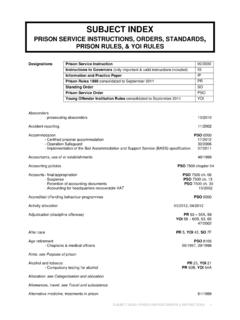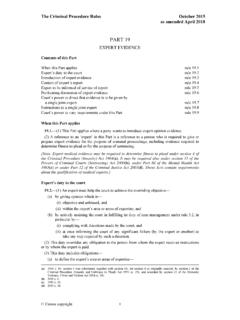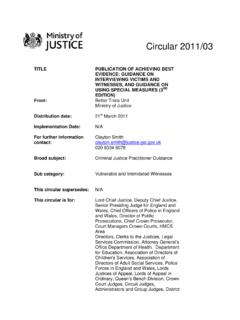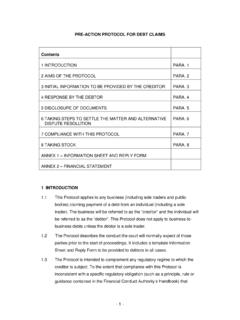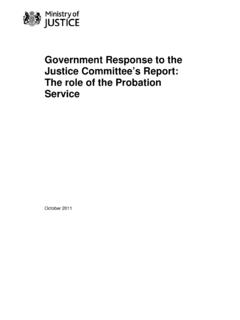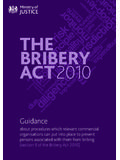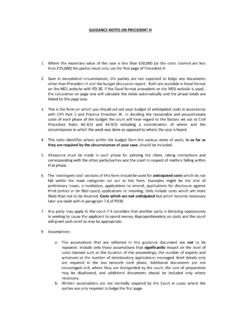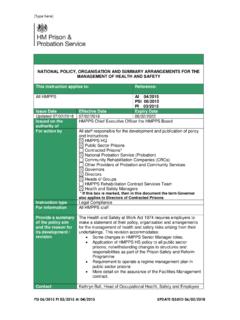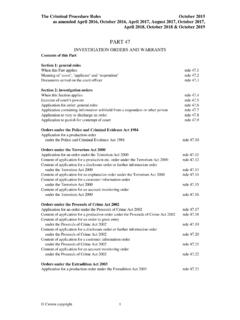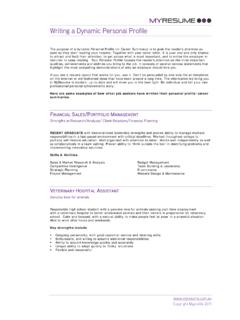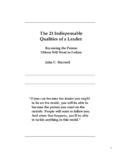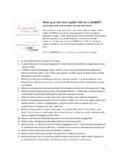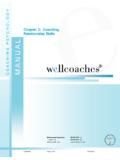Transcription of Competency and Qualities Framework - Justice
1 Competency and Qualities Framework C o m p e t e n c y a n d Q u a l i t i e s F r a m e w o r kWelcome to the new Competency and Qualities Framework (CQF) for the Prison Service. The CQF competencies describe behaviours that the Prison Service encourages among its staff. It is designed to enable employees at Senior Manager A and below and their managers to know what is expected of them in terms of clear and observable indicators of behaviour that apply across most situations they are likely to face. It does not describe what has to be done but how they should be done. The way in which people interact with each other in performing their duties especially those in authority has a significant impact on the culture of the organisation which not only impacts on staff but also on CQF has been developed by the Prison Service to reflect: Prison Service values; The law; Current and prospective business requirements; The Prison Service s commitment to equality and diversity.
2 Professional skills for Government (PSG) core skills and leadership o m p e t e n c y a n d Q u a l i t i e s F r a m e w o r k So, for example, for a Prison Officer, groups 1 and will apply, while for a non-operational manager G, indicator groups 1 and 3b will , it might be appropriate to make use of certain indicators from a different indicator set - see separate guidance on using the CQF in SPDR development planning, recruitment and filling Framework also provides some illustrations of activities the Service would not expect to see a competent person undertaking. By providing a contrast to the behaviours described in the indicators, these illustrations should help people to form a clearer and stronger idea of what positive behaviour looks should the CQF be used?The CQF is designed to support: The Staff Performance and Development Review (SPDR) the CQF replaces the existing Core Competence Framework (CCF) previously used in the development section of the SPDR form.
3 Separate guidance on how to use this Framework as part of the SPDR assessment will be available for staff and managers. Recruitment and selection job information packs will need to reflect a representative set of the required competencies for the role and candidates will need to demonstrate Competency at application and interview. Job Simulation Assessment Centres (JSACS) the new CQF replaces the Core Management skills previously used for assessment of candidates Leadership development the competencies required for strategic leadership support the new Leadership Qualities Framework for the Service (see below) Learning and development learning and skills provision will be reviewed to support the staff in developing key competencies throughout their career in the Prison structure of the CQFThe Framework consists of twelve behavioural competences, grouped under three headings.
4 Working professionallyWorking With othersWorking to achieve resultsTo enable clear, evidenced and consistent judgements to be formed about the extent to which someone is demonstrating each of the competencies, the Framework provides examples of the specific actions, observable in day-to-day work, that we might expect a competent person to be taking. Those actions form the indicators within each Competency . By considering to what extent, and in what way, someone can be seen to be carrying out those actions, we can form a view on that person s overall behaviour; and so, in turn, decide whether that behaviour fits the given definition of actions that people are expected to take in order to demonstrate Competency will differ, depending on the person s role and responsibilities. For this reason, within each Competency , the CQF presents different sets of indicators for:1.
5 ALL STAFF foundation indicators that apply to all staff in the Prison Service regardless of their role2. ALL STAFF WHO REGULARLY WORK DIRECTLY WITH PRISONERS these are used in addition to the foundation indicators above3. MANAGERS one of three different sets apply depending on their management level. These are: a. First line manager (SO,EO etc) b. Middle management (generally PO, managers G-E) c. Senior management (generally senior managers A-D) C o m p e t e n c y a n d Q u a l i t i e s F r a m e w o r kHow does this link to other leadership and professional skills development programmes?1. leadership Qualities Framework Leadership development, including 360 degree feedback exercises, will be based on the Leadership Qualities Framework (LQF). Not all of the characteristics that define leadership excellence can be described in terms of the behavioural indicators found under the twelve competencies in the CQF.
6 They relate to people s attitudes and perceptions, as well as to what they do. The LQF has therefore been developed, as an enhanced version of the CQF. It comprises four Leadership Qualities : Every detailed element of the LQF maps back to one or more indicators in the CQF. The output of JSACs and other selection exercises can be mapped against Leadership Qualities as well as behavioural professional skills for government The Framework includes, among the indicators for Senior Management, customised versions of the Professional skills for Government Core skills requirements, set by the Civil Service Management Board for all Civil Servants at grade 6 and 7 and equivalent levels (our Senior Managers A-D). These are highlighted in italics. In addition, many of the other indicators also support the Core skills o m p e t e n c y a n d Q u a l i t i e s F r a m e w o r k 1.
7 WORKING PROFESSIONALLY1A. Achieving a safe and secure environmentPromotes and contributes to an orderly, safe and secure environment; both within own unit / establishment and across the Prison Showing resilienceIs consistently motivated, committed and able to perform duties in all situations1C. Acting with integrityConsistently acts in a principled, open and conscientious manner, and challenges unacceptable Respecting othersPromotes equality of opportunity; treating all people with fairness, dignity and respect. Challenges discriminatory behaviour, and upholds and fosters WORKING WITH OTHERS2A. Persuading and influencing Persuades, influences and listens to others, using reason and co-operation to reach Building relationships and team working Supporting each other and building relationships to achieve common Communicating effectively Communicates and receives ideas, views and information to achieve CaringShows concern for colleagues, prisoners, and others, recognising their needs and providing practical WORKING TO ACHIEVE RESULTS3A.
8 Problem solving and decision making Gathers information from a range of sources. Analyses information to identify problems and issues and makes effective Organising and maximising performance Plans and supervises activities and resources to maximise Embracing change Acknowledges the need to achieve positive change, and challenges existing Developing self and othersTakes ownership of personal development and encourages and supports the development of o m p e t e n c y a n d Q u a l i t i e s F r a m e w o r k 1. WORKING PROFESSIONALLY 1A. Achieving a safe and secure environment Promotes and contributes to an orderly, safe and secure environment; both within own unit / establishment and across the Prison indicators for ALL STAFF: Treats security as a matter of high priority Accurately and urgently reports security incidents and breaches Takes responsibility for the control of personal equipment and/or keys Challenges behaviour among colleagues that might undermine safety or security Works collaboratively with other functions and individuals to achieve a safe and secure environment Engages with other departments to reduce levels of violence, bullying, self harm and substance misuseAdditional indicators for ALL STAFF WHO WORK DIRECTLY WITH PRISONERS.
9 Contributes to the maintenance of physical security Deals with and reports incidents of assault and injuries to prisoners Challenges, addresses and reports violent and bullying behaviour in prisoners Supports the principles of dynamic security by treating the needs of prisoners individually; developing controlled, professional relationships with prisoners; and contributing to a constructive regime Encourages prisoners to take responsibility for dealing with personal challenges, such as substance abuse Addresses the risks posed by prisoners, to themselves and others Encourages prisoners to improve their behaviour Acts upon signs of substance abuse by prisoners Deals constructively and reasonably with prisoners complaints and problemsIllustrative examples of undermining safety and security: Leaving reporting of security incidents or breaches to others Ignoring recognised processes when dealing with and reporting incidents Accepting that some areas of the establishment might become no-go areas Allowing inappropriate behaviours amongst colleagues to go un-challenged Undervaluing the importance of prisoners complaints or problems Moving immediately into the adjudication process as the only means of challenging bad behaviour10 C o m p e t e n c y a n d Q u a l i t i e s F r a m e w o r kfirst line management Ensures the team contributes to the achievement of key indicators for achieving a safe and secure environment Ensures the team contributes to the maintenance of physical security Adopts and promotes the principles of dynamic security.
10 And translates them into plans and actions Ensures staff support victims of bullying, violence, self-harm or substance abuse Encourages staff to make best use of incentive schemes to improve prisoner behaviour 1A. Additional indicators for MANAGERSM iddle management Promotes an understanding of key priorities concerning safety and security Supports and implements strategies, policies and processes that contribute to the achievement of a safe & secure living and working environment Enables managers to maintain physical security Adopts and promotes the principles of dynamic security, and translates them into plans and actions Supports a culture in which violence and bullying are not tolerated Supports a culture in which victims of bullying or violence, and prisoners who are subject to self-harm or substance abuse.
